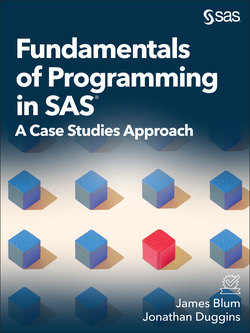Читать книгу Fundamentals of Programming in SAS - James Blum - Страница 4
На сайте Литреса книга снята с продажи.
ОглавлениеForeword
To Readers
This book is designed to help you develop an understanding of the SAS programming language and to help you develop good programming practices. It is intended as a learning guide and a skill builder, not as a reference book. To that end, it introduces sets of topics within each chapter that are connected through a single case study. Concepts are introduced on an as-needed basis to complete required tasks, so you are immediately exposed to writing complete programs. As further concepts are introduced they might be new topics, or they might revisit previously introduced topics at a more complex level. This reflects how many of the best SAS programmers have built their talents—by continually adding layers of knowledge onto a base set of skills. The book mimics this type of experience by increasing the complexity of the case study, requiring the addition of newer skills, or more complex versions of earlier skills, as they are needed.
Because of this circling back to content from previous chapters, a pedagogical concept known as a spiral curriculum, you will not learn everything this book covers on a topic in any single chapter. Of course, no one book could serve the purpose of giving a complete treatment of all concepts included; therefore, you will often be referred to outside resources, such as SAS Documentation, for a full description of syntax or for more detailed commentary. SAS Documentation is the standardized name used in this text for the collection of help files and examples provided by SAS. This documentation is available via the Help menu in SAS or online. Reading such references is a strategy commonly used by the best SAS programmers to refine their abilities and is an important habit for you to develop to build your skills as a SAS programmer and to expand on those skills in the future.
Due to the introduction of concepts in spiral fashion, it is important to begin with the setup material in Chapter 1 and then to proceed through the book sequentially. For easy reference, the numbering on all output in Chapters 1 through 7 directly corresponds to the number of the program that generates it. However, not all programs generate output. In all chapters, the programs, output, tables, and figures are numbered sequentially within each section. The same case study is used to provide continuity through the narrative when building on earlier concepts. Other case studies are also available for use to build continuity for additional programming activities and exercises. This includes a case study located in Chapter 8 for which the sections are aligned with the learning objectives of each chapter. Additional case studies are available online by visiting the author page for either author.
To Classroom Instructors
As stated in the previous section, this book is designed to tap into some of the best practices in educational theory as it spirals back onto topics throughout your course. It is designed by instructors with over 25 years of combined experience in teaching SAS either in the classroom or in industry. The more technical details are isolated in their own sections so that you can easily include or exclude them to fit the needs of your course. Multiple case studies are also provided so that the case study assignments can be customized for your students’ interests and to the content presented in your course. The case study provided in Chapter 8 ensures students have immediate access to a case study for reference while reading the text. Additional case studies are made available through the author pages for either author to ensure you get the benefit of updated materials on a regular basis. Any instructional materials will also be available either via the author pages (for public resources) or by contacting SAS to verify your status as an instructor (for instructor-only materials). These resources will be regularly updated.
About the IPUMS CPS Data
The IPUMS CPS data includes the Integrated Public Use Microdata Series (IPUMS) and Current Population Survey (CPS) beginning in 1962. These data sets provide person- and household-level information about a variety of demographic variables. A cross-section of recent data (2001, 2005, 2010, and 2015) was released for this publication and is included here as the main case study in the narrative. Visit https://cps.ipums.org to learn more about the IPUMS CPS or to extract newer data to continue honing your SAS programming skills.
